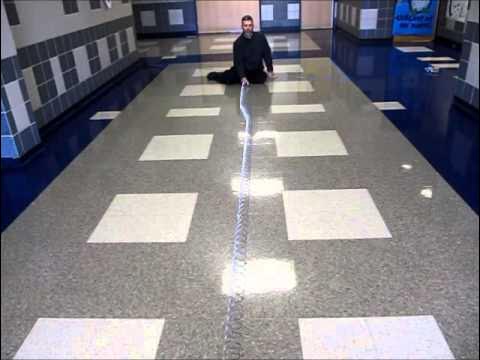Demonstrating Position, Velocity, and Acceleration of a Mass-Spring System
Summary
TLDRIn this engaging demonstration, Mr. P. walks through the process of studying a vertical mass-spring system in simple harmonic motion. Using a motion sensor and data analysis software, he examines position, velocity, and acceleration as functions of time. The video covers key concepts like amplitude, phase constant, and angular frequency, explaining how the system's behavior aligns with theoretical equations. Mr. P. also explores how errors accumulate in velocity and acceleration data and concludes by calculating the spring constant based on the period of motion. The hands-on approach brings these physics principles to life.
Takeaways
- 😀 The demonstration focuses on a vertical mass-spring system in simple harmonic motion, analyzing position, velocity, and acceleration as functions of time.
- 😀 A 305-gram mass is attached to a spring, with a motion sensor placed below to track its position over time.
- 😀 The initial position of the mass is used to set the motion into simple harmonic motion, where the position follows a cosine wave pattern.
- 😀 The equations for position, velocity, and acceleration are derived: position = amplitude × cos(angular frequency × time + phase constant), velocity = -amplitude × sin(angular frequency × time + phase constant), and acceleration = -amplitude × angular frequency² × cos(angular frequency × time + phase constant).
- 😀 The motion sensor only collects position data, meaning that velocity and acceleration are calculated from position data, leading to compounded errors in the velocity and acceleration graphs.
- 😀 Velocity and acceleration graphs show more error compared to the position graph because velocity depends on two position data points, and acceleration depends on two velocity data points.
- 😀 The period of the motion is calculated by measuring the time for two full cycles, yielding a period of 1.36 seconds.
- 😀 Even after just two cycles, the mass shows slight damping, with the maximum position dropping by 1 millimeter.
- 😀 Using the period formula for a mass-spring system, the spring constant is determined to be approximately 6.51 N/m.
- 😀 A best-fit sine wave is added to the position data, with the angular frequency used to confirm the period calculated earlier, validating the consistency of the experiment's results.
Q & A
What is the main goal of the demonstration presented in the video?
-The main goal is to demonstrate the motion of a vertical mass-spring system in simple harmonic motion, while analyzing position, velocity, and acceleration as a function of time, and collecting relevant data.
Why was a playing card added to the mass in the experiment?
-The playing card was added to the mass to make it easier for the motion sensor to detect the position of the mass. The card increases the surface area, helping the sensor more easily track the mass's motion.
What is the formula for position in simple harmonic motion?
-The formula for position as a function of time is: position(t) = A * cos(ωt + φ), where A is the amplitude, ω is the angular frequency, t is the time, and φ is the phase constant.
How does the motion sensor collect velocity and acceleration data?
-The motion sensor only collects position data. Velocity is calculated as the change in position over time (Δx/Δt), and acceleration is derived from the change in velocity over time (Δv/Δt).
Why is there more error in the acceleration data compared to the position data?
-The error in acceleration is greater because each acceleration data point is derived from two velocity measurements, and each velocity measurement is based on two position measurements. This compounds the errors, resulting in acceleration data having four times the error of position data.
What was the period of the mass-spring system determined in the experiment?
-The period was determined to be approximately 1.36 seconds based on the data from two full cycles of motion.
How did the amplitude of the oscillation change over time?
-The amplitude decreased slightly, showing a damping effect. After two full cycles, the amplitude had decreased by about 1 millimeter, indicating energy loss in the system.
How is the spring constant of the spring determined in this experiment?
-The spring constant is determined using the formula k = (4π²m) / T², where m is the mass and T is the period of the oscillation. Using the period of 1.36 seconds and a mass of 0.305 kilograms, the spring constant was calculated to be approximately 6.51 N/m.
What is the significance of the best-fit sine wave added to the graph?
-The best-fit sine wave represents the theoretical model of the oscillation, showing a sine function that approximates the motion of the system. It helps validate the experimental data and allows for the calculation of the angular frequency.
How does the angular frequency relate to the period in simple harmonic motion?
-The angular frequency (ω) is related to the period (T) by the equation ω = 2π / T. In this case, the angular frequency derived from the best-fit sine wave was 4.66 rad/s, leading to a period of approximately 1.35 seconds, which is close to the experimentally determined period.
Outlines

このセクションは有料ユーザー限定です。 アクセスするには、アップグレードをお願いします。
今すぐアップグレードMindmap

このセクションは有料ユーザー限定です。 アクセスするには、アップグレードをお願いします。
今すぐアップグレードKeywords

このセクションは有料ユーザー限定です。 アクセスするには、アップグレードをお願いします。
今すぐアップグレードHighlights

このセクションは有料ユーザー限定です。 アクセスするには、アップグレードをお願いします。
今すぐアップグレードTranscripts

このセクションは有料ユーザー限定です。 アクセスするには、アップグレードをお願いします。
今すぐアップグレード関連動画をさらに表示

Demonstrating Rotational Inertia (or Moment of Inertia)

Conservation of Angular Momentum Introduction and Demonstrations

Usei 5 Ferramentas HACKERS do Mr Robot!

Want to Understand Momentum? Here's An Easy And Fun Experiment To Try At Home!

Slinky Demo

How a Single Webinar Outperformed 6 Months of Paid Ads!
5.0 / 5 (0 votes)
